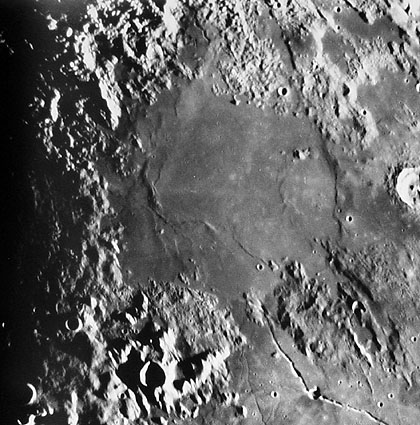Difference between revisions of "August 21, 2004"
| Line 4: | Line 4: | ||
<table width="85%" border="0" align="center" cellpadding="6" cellspacing="2"> | <table width="85%" border="0" align="center" cellpadding="6" cellspacing="2"> | ||
<tr> | <tr> | ||
| − | <td> | + | <td><h2>Vaporum: Crater or Basin?</h2></td> |
| + | <td><blockquote> | ||
</blockquote></td> | </blockquote></td> | ||
</tr> | </tr> | ||
| Line 57: | Line 58: | ||
---- | ---- | ||
===COMMENTS?=== | ===COMMENTS?=== | ||
| − | + | Register, and click on the <b>Discussion</b> tab at the top of the page. | |
Revision as of 16:25, 11 January 2015
Vaporum: Crater or Basin?
Vaporum: Crater or Basin? |
|
Vaporum: Crater or Basin? Have you noticed the circular patch of mare that cuts into the back slope of the Apennine mountains? With the name Mare Vaporum you may think there is little there but vaporous nothingness, but look more closely. The edge of the mare clearly defines a circle about 230 km in diameter - in between Schickard (206 km) and Clavius (245 km) in size. Arcuate - i.e. curved - mare ridges on the western portion of Vaporum suggest a possible 125 km wide inner ring (similar to the farside peak ring basin Schrodinger) and a ridge near the eastern side makes the idea just tenable. At it's southeast end, Vaporum's dark mare basalts cover older, lighter material. You can see that the norhtwestern end of the Hyginus Rille terminates because it is covered by younger Vaporum lavas, and the lavas oozed southeastward into the graben near Hyginus W. There is a hint of a large buried/ghost crater between the mountain Manilius Beta and the crater Manilius D. The dome next to Beta is just one of the many volcanic features in this area (notice the dark halo crater - DHC on the mouseover), but other than the veneer of dark pyroclastic material to the SE and W, most of the features are too small to see from Earth. But explore the Lunar Orbiter IV image. Technical Details: Related Links: Tomorrow's LPOD: Schrodinger |
Author & Editor: Technical Consultant: A service of: |
COMMENTS?
Register, and click on the Discussion tab at the top of the page.




